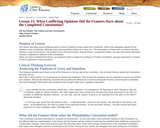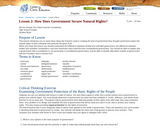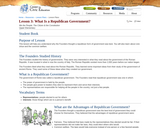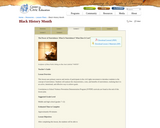
These resources accompany the lesson, In the Shadows, Agents of Change.
- Subject:
- Social Studies
- Material Type:
- Lesson Plan
- Provider:
- Center for Civic Education
- Date Added:
- 06/27/2017

These resources accompany the lesson, In the Shadows, Agents of Change.

In this lesson, students will be able to show where American democracy can be found within Article III of the Constitution. Students will take a position and defend it based on Article III and American principles of democracy and justice.

In this lesson, students acquire deeper understanding of the Constitution and its history and provide a reason for the study of the Constitution.

This lesson describes some conflicting points of view of leading Framers about the Constitution. Most of the delegates argued for the adoption of the Constitution, although many had reservations about all or parts of it. The reservations of three were so serious that they refused to sign the document. The position of one of these Framers, George Mason, is explored in detail. Students will also examine Benjamin Franklin's statement in defense of the Constitution. When they have completed this lesson, they should be able to explain the positions of Franklin and Mason, and give arguments in support of and in opposition to these positions.

This lesson introduces students to some basic ideas the Framers used in creating the kind of government they thought would best protect the natural rights of each individual and promote the good of all.

In this lesson, students gain an understanding of why the Founders thought a republican form of government was best, as well as learn about civic virtue and the common welfare.

In this lesson, students will create a five part letter exploring the following themes: What is responsibility? What is the importance of responsibility? How can we be responsible? How does personal responsibility affect our world?

In this lesson, students will be able to develop a poem that describes justice in their own words and expressively read aloud poems using modulated intonation and pacing.

In this lesson, students will analyze major figures in the history of nonviolence and the framework of philosophic nonviolence vs. tactical nonviolence. Students will participate in hypothetical situations based on historical events.

In this 2 day lesson, students will explore how music can influence social and political change in society. Students will look at modern day protest music as well as investigate music from the civil rights movement, as well as work in groups to research songs.

In this lesson, students will explore the concept of nonviolence through primary sources and narratives from the civil rights movement. Handouts and links provided.

In this lesson, students are asked to look not just at the events of 9/11 but at the following days and years. The lessons involve students in exploring the parts of a newspaper, the functions of a news article, and the importance of a free press in a democratic society. Classroom activities prompt students to discuss the need for and role of heroes. Students learn how to identify unifying factors in a diverse society, distinguish between fact and opinion, examine different points of view, analyze legal issues that have arisen as a result of the terrorist attacks, and much more. Lesson four, Today’s Hero, also includes activities for grades K–4.

In this lesson, students learn about responsibility and apply the concept to segments of the U.S. Constitution.

In this lesson, students will analyze the Grimm fairy tale, Rumpelstiltskin, and determine if a breach of contract occurred. Students will be able to clearly define justice, contract, and responsibility. Students will be able to identify specific abuses of power and authority. Students will evaluate behaviors of individuals’ authority, power and responsibility.

In this lesson, students read Kellogg's The Island of Skog, discuss key components of a democratic government and will write three rules they believe the residents of the island should follow.

In this lesson, students examine the recent proposed amendments to the U.S. Constitution, analyze them for public policy triggering mechanisms, and compare and contrast them to amendments that have been ratified.

In this lesson, students will complete poem using the pattern sheet. Students will explore the questions: What is the responsibility? What is the importance of responsibility? How can we be responsible?

Many of the ideas that influenced the Founders originated in the government of the Roman Republic. This lesson provides an opportunity for students to explore and discuss the meaning of republicanism, common welfare, and civic virtue as they were said to have been practiced in ancient Rome, and to consider how these ideas influenced the thinking and behavior of the Founders.

In this lesson, students will analyze one of six amendments to the U.S. Constitution through the framework of its economic, political, social or cultural, and international contexts. Using the information that they gather, students are instructed to create timelines that encompass both the amendment and pertinent events before, during, and after adoption of the amendment. These timelines will then be combined so that students can more fully evaluate and interpret how the U.S. Constitution has evolved in the historical context of our democracy.

This lesson involves students in a number of critical thinking exercises. Each exercise presents a series of quandaries representing many great ideas and principles that have shaped our constitutional heritage, some
contradictory but of equal merit to the others. In each exercise, students apply principles and ideas to a contemporary issue and then take a position and defend their judgments.